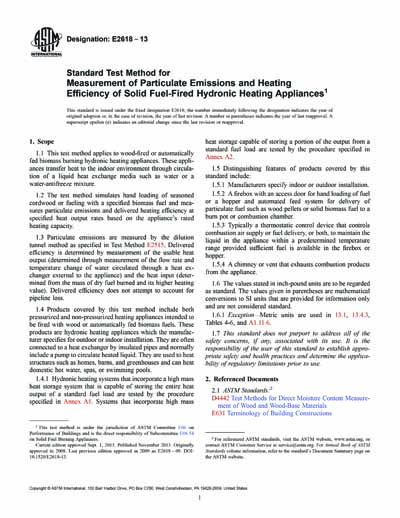Historical
ASTM E2618-13
Standard Test Method for Measurement of Particulate Emissions and Heating Efficiency of Solid Fuel-Fired Hydronic Heating Appliances
1.1 This test method applies to wood-fired or automatically fed biomass burning hydronic heating appliances. These appliances transfer heat to the indoor environment through circulation of a liquid heat exchange media such as water or a water-antifreeze mixture.
1.2 The test method simulates hand loading of seasoned cordwood or fueling with a specified biomass fuel and measures particulate emissions and delivered heating efficiency at specified heat output rates based on the appliance’s rated heating capacity.
1.3 Particulate emissions are measured by the dilution tunnel method as specified in Test Method E2515. Delivered efficiency is determined by measurement of the usable heat output (determined through measurement of the flow rate and temperature change of water circulated through a heat exchanger external to the appliance) and the heat input (determined from the mass of dry fuel burned and its higher heating value). Delivered efficiency does not attempt to account for pipeline loss.
1.4 Products covered by this test method include both pressurized and non-pressurized heating appliances intended to be fired with wood or automatically fed biomass fuels. These products are hydronic heating appliances which the manufacturer specifies for outdoor or indoor installation. They are often connected to a heat exchanger by insulated pipes and normally include a pump to circulate heated liquid. They are used to heat structures such as homes, barns, and greenhouses and can heat domestic hot water, spas, or swimming pools.
1.4.1 Hydronic heating systems that incorporate a high mass heat storage system that is capable of storing the entire heat output of a standard fuel load are tested by the procedure specified in Annex A1. Systems that incorporate high mass heat storage capable of storing a portion of the output from a standard fuel load are tested by the procedure specified in Annex A2.
1.5 Distinguishing features of products covered by this standard include:
1.5.1 Manufacturers specify indoor or outdoor installation.
1.5.2 A firebox with an access door for hand loading of fuel or a hopper and automated feed system for delivery of particulate fuel such as wood pellets or solid biomass fuel to a burn pot or combustion chamber.
1.5.3 Typically a thermostatic control device that controls combustion air supply or fuel delivery, or both, to maintain the liquid in the appliance within a predetermined temperature range provided sufficient fuel is available in the firebox or hopper.
1.5.4 A chimney or vent that exhausts combustion products from the appliance.
1.6 The values stated in inch-pound units are to be regarded as standard. The values given in parentheses are mathematical conversions to SI units that are provided for information only and are not considered standard.
1.6.1 Exception—Metric units are used in 13.1, 13.4.3, Tables 4-6, and A1.11.6.
1.7 This standard does not purport to address all of the safety concerns, if any, associated with its use. It is the responsibility of the user of this standard to establish appropriate safety and health practices and determine the applicability of regulatory limitations prior to use.
Content Provider
ASTM International [astm]






